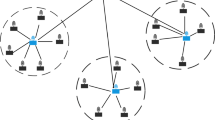Abstract
Nowadays, the energy consumption has become one of the major constraints for the sensor nodes having a finite energy source in the design of Wireless sensor networks (WSNs). In this paper, a new routing concept using divide-and-rule sectorization (DRS) scheme has been proposed to curtail the energy efficiency issues in WSNs. In this scheme, each forwarder node is dynamically selected for WSNs which balances the energy consumption among the sensor nodes significantly. The network area is divided into subareas to reduce the unbalance loading condition, and each subarea known as the segment, efficiently decrease the energy hole creation problem of the network. Moreover, the analytical analysis of the energy consumption for the proposed scheme has also been presented. The simulation results confirm that the proposed DRS scheme has better enduring stability, prolonging network lifetime, and minimized energy consumption as compared to available state-of-the-arts.











Similar content being viewed by others
References
Xiangning, F., Yulin, S. (2007). Improvement on leach protocol of wireless sensor network. In 2007 International Conference on Sensor Technologies and Applications (SENSORCOMM 2007), IEEE, pp. 260–264.
Liu, A.-F., Zhang, P.-H., & Chen, Z.-G. (2011). Theoretical analysis of the lifetime and energy hole in cluster based wireless sensor networks. Journal of Parallel and Distributed Computing, 71(10), 1327–1355.
Shi, S., Liu, X., Gu, X. (2012). An energy-efficiency optimized leach-c for wireless sensor networks. In: 7th International Conference on Communications and Networking in China, IEEE, pp. 487–492.
Latif, K., Ahmad, A., Javaid, N., Khan, Z. A., & Alrajeh, N. (2013). Divide-and-rule scheme for energy efficient routing in wireless sensor networks. Procedia Computer Science, 19, 340–347.
Ahmad, A., Latif, K., Javaidl, N., Khan, Z. A., Qasim, U. (2013). Density controlled divide-and-rule scheme for energy efficient routing in wireless sensor networks. In 2013 26th IEEE Canadian Conference on Electrical and Computer Engineering (CCECE), IEEE, pp. 1–4.
Amjad, N., Javaid, N., Haider, A., Awan, A., Rahman, M. (2013). Dreem-me: distributed regional energy efficient multi-hop routing protocol based on maximum energy in WSNS. In (2013). Eighth International Conference on Broadband and Wireless Computing (pp. 43–48). IEEE: Communication and Applications.
Haider, A., Javaid, N., Amjad, N., Awan, A., Khan, A., Khan, N. (2013). Reech-me: Regional energy efficient cluster heads based on maximum energy routing protocol for WSNS. In (2013). Eighth International Conference on Broadband and Wireless Computing (pp. 88–92). IEEE: Communication and Applications.
Ben-Othman, J., Bessaoud, K., Bui, A., & Pilard, L. (2013). Self-stabilizing algorithm for efficient topology control in wireless sensor networks. Journal of Computational Science, 4(4), 199–208.
Sabri, A., & Al-Shqeerat, K. (2014). Hierarchical cluster-based routing protocols for wireless sensor networks-a survey. International Journal of Computer Science Issues (IJCSI), 11(1), 93.
Nazari Talooki, V., Rodriguez, J., & Marques, H. (2014). Energy efficient and load balanced routing for wireless multihop network applications. International Journal of Distributed Sensor Networks, 10(3), 927659.
Saleem, F., Moeen, Y., Behzad, M., Hasnat, M., Khan, Z. A., Qasim, U., & Javaid, N. (2014). Iddr: improved density controlled divide-and-rule scheme for energy efficient routing in wireless sensor networks. Procedia Computer Science, 34, 212–219.
Latif, K., Javaid, N., Saqib, M. N., Khan, Z. A., Qasim, U., Mahmood, B., & Ilahi, M. (2015). Energy hole minimization with field division for energy efficient routing in WSNS. International Journal of Distributed Sensor Networks, 11(10), 953134.
Singh, K., Daniel, A. (2015). Load balancing in region based clustering for heterogeneous environment in wsns using ai techniques. In 2015 Fifth International Conference on Advanced Computing & Communication Technologies, IEEE, pp. 641–646.
Latif, K., Javaid, N., Saqib, M. N., Khan, Z. A., & Alrajeh, N. (2016). Energy consumption model for density controlled divide-and-rule scheme for energy efficient routing in wireless sensor networks. International Journal of Ad Hoc and Ubiquitous Computing, 21(2), 130–139.
Yang, L., Lu, Y.-Z., Zhong, Y.-C., & Yang, S. X. (2018). An unequal cluster-based routing scheme for multi-level heterogeneous wireless sensor networks. Telecommunication Systems, 68(1), 11–26.
Behzad, M. (2018). M-BEHZAD: minimum distance based energy efficiency using hemisphere zoning with advanced divide-and-rule scheme for wireless sensor networks. 6th Annual Students Scientific Forum by King Fahd University of Petroleum and Minerals, Saudi Arabia, CoRR abs/1804.00898. arXiv:1804.00898.
Jha, S. K., & Eyong, E. M. (2018). An energy optimization in wireless sensor networks by using genetic algorithm. Telecommunication Systems, 67(1), 113–121.
Sharma, G., & Kumar, A. (2018). Improved dv-hop localization algorithm using teaching learning based optimization for wireless sensor networks. Telecommunication Systems, 67(2), 163–178.
Sirsikar, S., & Chandak, M. (2018). Efficient clustering using concentric rings and rectangular region formations in wireless sensor networks. International Journal of Applied Engineering Research, 13(6), 3483–3491.
Khan, I., & Singh, D. (2018). Energy-balance node-selection algorithm for heterogeneous wireless sensor networks. ETRI Journal, 40(5), 604–612.
Tang, W., Zhang, K., & Jiang, D. (2018). Physarum-inspired routing protocol for energy harvesting wireless sensor networks. Telecommunication Systems, 67(4), 745–762.
Author information
Authors and Affiliations
Corresponding author
Additional information
Publisher's Note
Springer Nature remains neutral with regard to jurisdictional claims in published maps and institutional affiliations.
Rights and permissions
About this article
Cite this article
Kumar, S., Gautam, P.R., Rashid, T. et al. Division Algorithm Based Energy-Efficient Routing in Wireless Sensor Networks. Wireless Pers Commun 122, 2335–2354 (2022). https://doi.org/10.1007/s11277-021-08996-x
Accepted:
Published:
Issue Date:
DOI: https://doi.org/10.1007/s11277-021-08996-x




